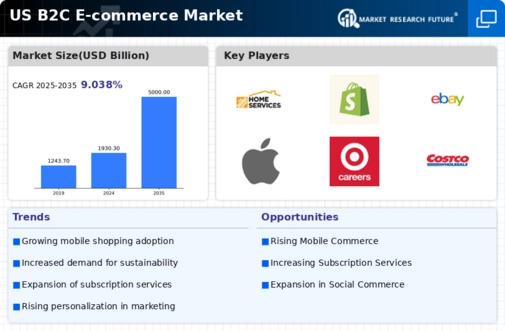The US B2C E-commerce Market has experienced a dynamic evolution over the years, driven by changing consumer behaviors, advancements in technology, and increased reliance on digital shopping platforms. This market showcases a competitive landscape characterized by a mix of established players and emergent platforms that continuously strive to capitalize on the growing demand for online shopping.
Factors such as convenience, diverse product offerings, and personalized shopping experiences are paramount in shaping the preferences and spending habits of consumers. Companies are increasingly investing in innovative strategies, such as adopting omnichannel approaches and leveraging advanced analytics, to enhance customer engagement and optimize their market positions.
Understanding the competitive dynamics is crucial for businesses aiming to capture market share and foster long-term growth within this increasingly crowded space.
Home Depot stands out in the US B2C E-commerce Market by leveraging its strong presence in the home improvement sector. The company's robust online platform complements its extensive network of physical stores, allowing it to provide a seamless shopping experience for customers.
With a strong focus on DIY and professional contractors, Home Depot has established itself as a go-to destination for tools, construction materials, and home improvement products. Its strengths lie in a well-curated product assortment, competitive pricing, and exceptional customer service.
Furthermore, the company effectively utilizes technology to enhance its online shopping capabilities, offering features like virtual reality tools for home projects and comprehensive product information online. This synergy between online and offline channels enables Home Depot to meet the diverse needs of its customer base while positioning it favorably against competitors in the E-commerce landscape.
Shopify has emerged as a key player in the US B2C E-commerce Market, providing a robust platform that enables businesses of all sizes to create and manage their own online stores. With key services such as website creation, payment processing, and logistics support, Shopify empowers entrepreneurs to easily launch and scale their E-commerce ventures.
The company's strengths include its user-friendly interface, comprehensive support resources, and a vast ecosystem of apps and integrations that enhance the functionalities of online stores. Additionally, Shopify has formed strategic partnerships and made acquisitions that further enhance its offerings and market presence.
By continuously innovating and adapting to changing market demands, Shopify has positioned itself as a leader in empowering businesses to succeed in the fast-paced E-commerce environment of the US, cementing its role as an essential service provider for aspiring online retailers.












